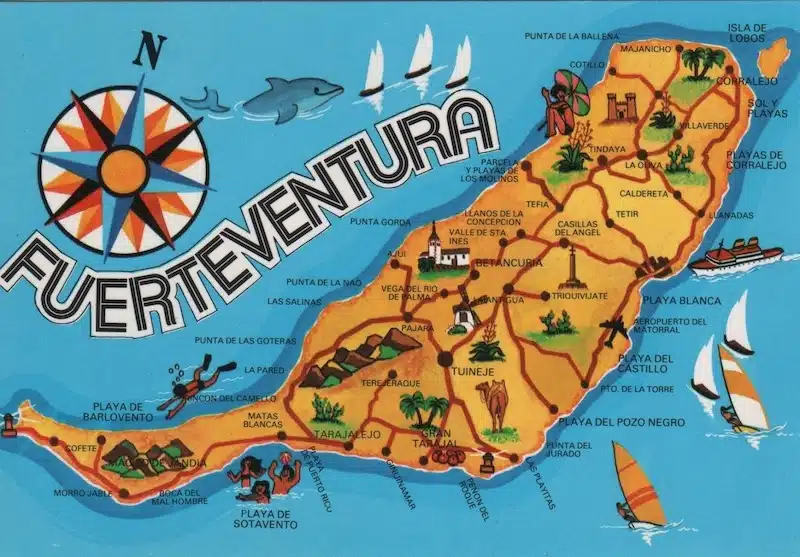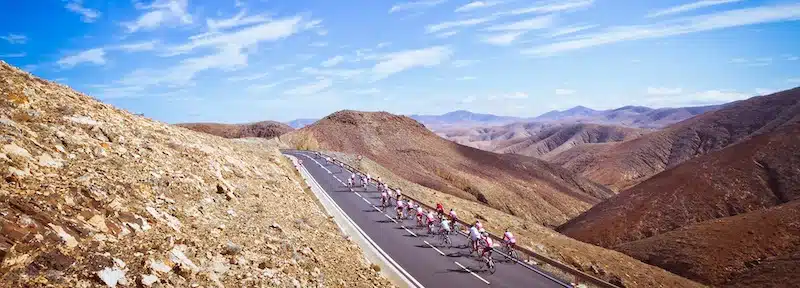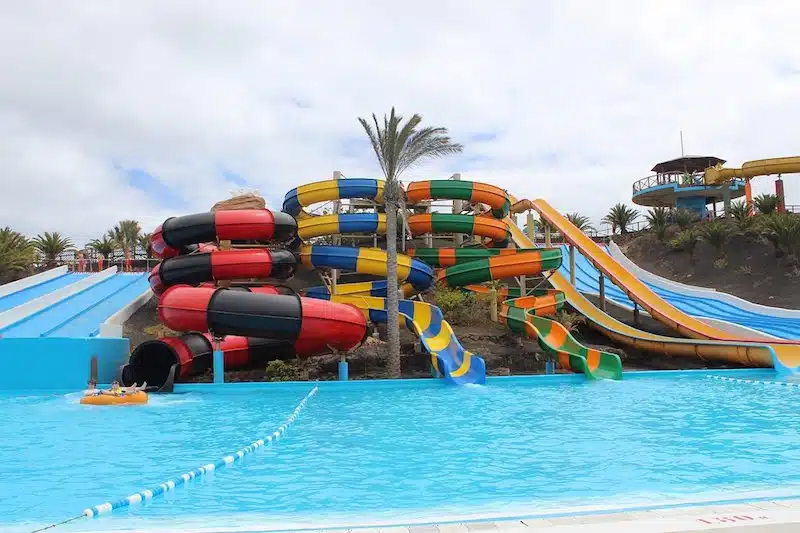Welcome, traveler, to the wild, arid, and yet inexplicably enchanting island of Fuerteventura. Known as the oldest of the Canary Islands, her history is a quilt of conquests, resilience, and evolution. So, without further ado, let’s journey back in time to unveil the enigmatic story of this island paradise.
A Brief History of Fuerteventura
In the Beginning: Ancient Whispers (1000 BCE – 1402)
Our saga begins around 1000 BCE, when the first inhabitants, the Majos, arrived, possibly from North Africa. They were a simple folk, living in caves and stone huts, shepherding goats, and making pottery. Theirs was a life deeply intertwined with the raw, rugged beauty of Fuerteventura, leaving behind whispers of their existence through petroglyphs and artifacts.
The Majos, the original inhabitants of Fuerteventura, were a people shrouded in mystery. As per the archaeological evidence and historical records available, they likely arrived from North Africa around 1000 BCE. The Majos were primarily pastoralists, known for their sheep and goat herding skills. They also engaged in farming, cultivating crops like barley and wheat, and were adept fishermen.
The Majos lived all across Fuerteventura, with archaeological sites scattered throughout the island. They built stone huts, known as ‘tamasite’, and also made use of natural caves for habitation. Their homes were often grouped together to form small communities.
One of the most significant archaeological sites is La Atalayita, an ancient village located in the municipality of Antigua. Here, you can see remnants of their stone dwellings, as well as structures believed to have been used for religious and social ceremonies. The site of Tindaya Mountain, considered sacred by the Majos, also holds numerous rock carvings.
The influence of the Majos is still evident in Fuerteventura’s culture, particularly in traditional crafts like pottery and weaving. The island’s Museo de la Alfarería (Pottery Museum) in Antigua showcases traditional Majo pottery techniques, and the Casa de los Coroneles in La Oliva exhibits traditional Canarian architecture, influenced by the Majos.
Chapter of Chains: The Norman Conquest (1402 – 1492)
The peace of the Majos was shattered when the sails of Jean de Béthencourt and Gadifer de la Salle, Norman knights under the auspices of the Castilian crown, appeared on the horizon in 1402. Despite initial resistance, the Majos succumbed to the superior military might of the invaders, thus marking the beginning of a new era – the age of the Europeans.
The Spanish Era: A New Dawn (1492 – 1852)
With the complete conquest of the Canaries by the Spanish in 1492, Fuerteventura found itself a cog in the larger machinery of the Spanish Empire. The island was primarily used as a source of grain, and as a pastureland for livestock. However, these years were marred by pirate attacks, with the island’s inhabitants living in a constant state of uncertainty and fear.
The Phoenix Rises: From Obscurity to Prominence (1852 – 1970s)
The mid-19th century saw Fuerteventura, like a phoenix, rising from the ashes of obscurity. Granted the status of a free trade zone in 1852, the island saw a slight surge in economic activity. However, the real transformation came only in the 20th century, with two significant events.
Firstly, the Spanish Civil War, which despite its horrors, led to the construction of the island’s first airport for military purposes. Secondly, the advent of the Francisco Franco’s regime saw the establishment of a foreign legion garrison and a penal colony on the island. This marked the beginning of the island’s slow march towards modernity.
The Song of the Sea: The Growth of Tourism (1970s – 2024)
The close of the Franco era in the 1970s marked a turning point in Fuerteventura’s tale. The windswept beaches and azure waters, once only the companions of the Majos, started attracting attention from far and wide. The island’s first resort, Corralejo, sprang up in the north, and the airport, once a symbol of conflict, became the gateway for tourists.
The last 30 years, from the 1990s to the present day, have seen an exponential growth in tourism. The island, once a solitary figure in the Atlantic, now hosts more than half a million visitors a year, who come to enjoy the idyllic beaches, the mesmerizing dunes, and the unique biosphere reserves. Tourism has become the lifeblood of Fuerteventura, transforming its economy and lifestyle, while still striving to preserve the island’s unique natural beauty and history.
And thus, we arrive back to the present day. From the humble Majos to the bustling tourist hub, Fuerteventura has seen the ebb and flow of time, cultures, and civilizations. Her history is a testament to the resilience of nature and humanity, a story etched by the winds on the sands of this magnificent island.
15 Points of Interest on Fuerteventura
- Corralejo Dunes Natural Park: This vast expanse of sand dunes is a protected natural space that resembles a mini desert. It’s a wonderful place for walks and photographs.
- Isla de Lobos: A small island located just 2 kilometers north of Fuerteventura. It’s a nature reserve with beautiful beaches and walking trails, and it’s home to a variety of bird species.
- Cofete Beach: A stunning, remote beach on the Jandía Peninsula, known for its beauty and isolation. The mountain backdrop and wide sandy beach make it a unique spot.
- Tindaya Mountain: A sacred place for the island’s original inhabitants, with over 300 engravings at the top, believed to ward off evil spirits.
- Betancuria: The island’s former capital, it’s filled with charming whitewashed houses and cobblestone streets. The Santa Maria church and the Museum of Archaeology and Ethnography are highlights.
- El Cotillo: A small fishing village renowned for its beautiful lagoons and beaches. The Tostón Tower here is a defensive structure from the 18th century.
- Casa de los Coroneles: In La Oliva, this grand, colonial-style house from the 17th century once served as the residence for the island’s military governors.
- Ajuy Caves: Coastal caves formed by the erosion of the sea against the limestone cliffs, located in the small fishing village of Ajuy.
- Oasis Park: A large zoo and botanical garden located in La Lajita, it’s home to a variety of animals, including camels, and offers camel rides.
- Morro Jable: A popular resort town in the south with beautiful beaches. The Morro Jable Lighthouse here is one of the tallest in the Canaries.
- Salt Museum: Located in the town of Salinas del Carmen, this museum offers insight into the traditional process of sea salt extraction.
- Calderon Hondo: A well-preserved volcanic cone with a walking trail leading to the top, offering panoramic views of the island.
- Puerto del Rosario: The capital of the island, with a range of shops, restaurants, and the popular sculpture park along the Avenida Maritima.
- La Alcogida Ecomuseum: A museum in Tefia where you can explore restored traditional farmhouses and learn about the island’s agricultural practices.
- Villa Winter: A mysterious villa in Cofete, surrounded by numerous conspiracy theories related to World War II.
These are just a few of the many interesting places to explore in Fuerteventura, if you would like more things to do on Fuerteventura we have 30 things for you to do during your holiday!
Activities on Fuerteventura
Imagine a warm breeze carrying the tang of the sea, mingling with the rugged scent of volcanic rock. You’re standing on Fuerteventura, the second-largest of Spain’s Canary Islands, a paradise for adventurers, thrill-seekers, and peace-lovers alike. This place is filled with activities, where every day can be a unique exploration.
Walking and Hiking: Walking and hiking on Fuerteventura is like taking a step back in geological time. The island’s volcanic origins have sculpted an intricate tapestry of mountains, valleys, and plains, providing endless trails for walking and hiking. Venture through the lunar landscapes of the Malpais de la Arena, or ascend the sacred Tindaya Mountain, where ancient Majos left mysterious carvings. The Barranco de las Peñitas, a gorgeous canyon with a chapel hidden in the rocks, is another popular hiking trail.
Water Sports: Fuerteventura is a magnet for watersport enthusiasts. The island is internationally renowned for its consistent wind conditions, making it a windsurfer’s and kitesurfer’s paradise. The annual Windsurfing and Kiteboarding World Cup held in Sotavento is a testament to this. If you prefer underwater adventures, don’t miss out on scuba diving and snorkeling in the clear turquoise waters, exploring the diverse marine life and beautiful underwater landscapes.
Motor Sports: Feel the rush of adrenaline as you race over the island’s rough terrains on a quad bike or a buggy. The island hosts various off-road motorsport events throughout the year, including the Fuerteventura 4×4 Festival. For a more relaxed experience, you can also explore the island’s scenic roads by motorcycle or convertible.
Beach Activities: With over 150 beaches, Fuerteventura offers a beach for every mood. Whether you want to build sandcastles, sunbathe, or play beach volleyball, you’ll find the perfect spot. Don’t forget to visit the expansive dunes of Corralejo Natural Park, where you’ll feel like you’ve stepped into a mini desert.
Star-gazing: Once the sun sets, another of Fuerteventura’s treasures reveals itself – its night skies. With low light pollution, the island offers some of the best stargazing opportunities. Join a guided astronomical tour or simply lie back on a beach and watch the stars put on a celestial show.
Cycling: With its wide plains and challenging hills, Fuerteventura offers excellent cycling routes. Cycle along the coast, feeling the sea breeze, or tackle the more challenging mountain routes for a fantastic workout with a view.
Cultural Exploration: Step into the island’s past with a visit to the open-air museum at La Atalayita or explore the arts scene at the cultural center in the El Tostón lighthouse. Try your hand at pottery classes, inspired by traditional Majorero techniques, or explore the vibrant markets in the island’s towns.
Whether you are an adrenaline junkie, a nature enthusiast, or a culture vulture, Fuerteventura promises a memorable experience. With its diverse landscapes and rich cultural heritage, the island offers an adventure for every kind of traveler.
Weather on Fuerteventura
Known as the island of eternal spring, Fuerteventura, like the rest of the Canary Islands, enjoys a pleasant subtropical climate year-round. The island is characterized by more than 3,000 hours of sunshine annually, making it a popular destination for sun-seekers.
Temperature
The average annual temperature in Fuerteventura hovers around 20-22°C (68-72°F). In the summer months, from June to September, the average highs usually range between 25-28°C (77-82°F), while the average lows are about 19-21°C (66-70°F). In the winter months, from December to February, the average highs are around 20-21°C (68-70°F), and the average lows drop to about 14-15°C (57-59°F). It’s worth noting that the sea has a moderating effect on the climate, preventing extreme temperatures.
Precipitation
Fuerteventura is the driest of the Canary Islands. The island sees scarce rainfall, usually concentrated in the winter months. The average annual rainfall is less than 150mm, with coastal areas receiving even less. In general, the island’s landscape is quite arid, shaped by centuries of minimal rainfall and persistent winds.
Wind
Fuerteventura, which translates to “strong fortune,” could also be interpreted as “strong wind,” a fitting name given the island’s windy conditions. The northeast trade winds are a constant feature, with stronger winds typically occurring in the summer months. This makes the island a paradise for wind sports like windsurfing and kiteboarding.
Overall, Fuerteventura offers a warm, sunny climate that is inviting at any time of the year. However, it’s always a good idea to check the current forecast before traveling.
Average Monthly Weather Forecast
| Month | Temperature (°F) | Rainfall (in) | Hours of Sunshine | Sea Temperature (°F) | Wind Speed (mph) | Wind Gusts (mph) |
| Jan | 69.8 | 1.4 | 7 | 66.2 | 11.2 | 21.9 |
| Feb | 69.1 | 0.9 | 7 | 64.4 | 10.7 | 21.6 |
| Mar | 71.2 | 0.5 | 8 | 64.4 | 10.3 | 21.1 |
| Apr | 73.4 | 0.3 | 9 | 64.4 | 9.8 | 20.4 |
| May | 75.2 | 0.1 | 10 | 68 | 9.2 | 19.7 |
| Jun | 78.1 | 0 | 11 | 71.6 | 8.4 | 18.8 |
| Jul | 82.4 | 0 | 11 | 73.4 | 7.9 | 18.1 |
| Aug | 82.8 | 0 | 10 | 75.2 | 8.4 | 18.8 |
| Sep | 80.6 | 0.1 | 9 | 75.2 | 9.2 | 19.7 |
| Oct | 77 | 0.4 | 8 | 73.4 | 10.3 | 21.1 |
| Nov | 73.2 | 1.2 | 7 | 71.6 | 11.2 | 21.9 |
| Dec | 70.3 | 1.4 | 6 | 68 | 11.2 | 21.9 |
Fuerteventura Celebrities
As of time of writing this guide, there aren’t many internationally famous people known to have lived or currently live in Fuerteventura. The island is known more for its natural beauty than its celebrity residents. That said, there are a few notable people associated with the island:
- Cesar Manrique: The famous Canarian artist and architect didn’t live in Fuerteventura, but he had a significant influence on the island. He designed several landmarks in the Canary Islands, including the Mirador del Río in Lanzarote, and was instrumental in promoting environmentally-friendly tourism. His work can be seen in the El Tostón lighthouse in El Cotillo, Fuerteventura, which houses a cultural center.
- Josefina Plá: Born in the Canary Islands, this renowned writer, poet, and art critic lived in Fuerteventura during her early years. She is best known for her work in promoting Paraguayan culture, where she lived for most of her life.
- René Egli: A well-known figure in the world of windsurfing, René Egli chose Fuerteventura as the place to establish a windsurfing center due to the island’s consistent wind conditions. While not born in Fuerteventura, his connection to the island has helped put it on the map as a prime location for wind sports.
As for current residents, Fuerteventura, like the other Canary Islands, tends to attract those seeking a more relaxed lifestyle, including artists, writers, and athletes.
15 Interesting Facts About Fuerteventura
- Ancient Origins: Fuerteventura is the oldest of the Canary Islands, with its formation dating back around 20 million years.
- Mysterious Inhabitants: The island was originally inhabited by a people known as the Majos, believed to have arrived around 1000 BCE from North Africa.
- Name Origins: The name Fuerteventura is a combination of two Spanish words: “fuerte” (strong) and “ventura” (fortune). However, some believe it might also translate to “Strong Wind” due to the island’s windy conditions.
- A Biosphere Reserve: In 2009, UNESCO declared the whole island of Fuerteventura a Biosphere Reserve, owing to its unique flora and fauna.
- Land of Beaches: Fuerteventura is home to over 150 beaches, some of which are considered the most beautiful in the Canary Islands.
- Wind Sports Paradise: Thanks to its wind conditions, Fuerteventura is a favorite destination for wind sports such as windsurfing and kiteboarding. It hosts the Windsurfing and Kiteboarding World Cup annually.
- Impressive Dunes: The Corralejo Natural Park in the north of the island hosts a large expanse of sand dunes, reminiscent of a miniature desert.
- Goat Population: Fuerteventura has more goats than people! The island is known for its delicious goat cheese, called Majorero cheese.
- Star-gazing Spot: With its clear skies and low light pollution, Fuerteventura is a fantastic place for stargazing.
- Cave of Ajuy: The Ajuy caves on the west coast of Fuerteventura are a popular tourist attraction. The caves are formed from fossilized dunes and marine deposits.
- Island of Squirrels: Fuerteventura is home to a large population of Barbary Ground Squirrels, which were introduced to the island in the 1960s and have since thrived.
- Volcanic Landscapes: The island is home to several extinct volcanoes, and the landscape is characterized by volcanic hills and plains.
- Sacred Mountain: Tindaya Mountain, considered sacred by the ancient Majos, is known for its mysterious carvings, thought to ward off evil spirits.
- Underwater Museum: Fuerteventura is close to Europe’s first underwater museum, Museo Atlántico, located off the coast of neighboring Lanzarote.
- Film Destination: Its unique landscapes have made Fuerteventura a popular location for film shoots, including movies like “Exodus: Gods and Kings” and “The Dictator”.
Tourism on Fuerteventura
Tourism on Fuerteventura has been on a steady upward trend since the late 20th century. In 2019, for instance, the island welcomed approximately 2.3 million tourists. The majority of these visitors hailed from Germany, the United Kingdom, and other parts of Spain.
Growth of Hotels
Regarding hotel growth, the number of hotels and other tourist accommodations has indeed increased significantly over the last few decades, reflecting the growth in tourism. Notably, the island’s accommodation isn’t limited to traditional hotels; it also includes apartment rentals, vacation homes, and resorts, among other options. As of 2021, there were hundreds of options available for visitors to the island.
The Island’s Infrastructure
Regarding infrastructure, the island’s government has continuously invested in improving the road network to support the growth in tourism. The FV-1 and FV-2 are the primary roads that connect the north and south of the island, respectively. The exact timeline of these developments would be better obtained from local sources or the island’s government, as my training data only covers information up until 2021.
The development of tourism on Fuerteventura has been carefully managed to balance economic growth with environmental preservation. The island is known for its biosphere reserve status, and efforts have been made to ensure that tourism growth does not negatively impact the unique natural environment of Fuerteventura.
Conclusion
Fuerteventura, the oldest and the second-largest of the Canary Islands, is a destination that embodies a harmonious blend of history, natural beauty, and modern allure. Its story is as ancient and enduring as the volcanic formations that shape its landscape, dating back to the era of the Majos, its earliest known inhabitants. Throughout its history, Fuerteventura has seen periods of struggle, such as pirate invasions, and periods of growth and development, most notably in the rise of its tourism industry.
This island, with its year-round mild climate, offers an assortment of experiences for all types of travelers. From the adrenaline-pumping water sports in its azure waters and motor sports on its rough terrains, to tranquil walks and hikes through its diverse landscapes, Fuerteventura promises a plethora of adventures. Its commitment to ecotourism is evident in the preservation of its stunning natural spaces, such as the Corralejo Dunes Natural Park, and its efforts to maintain low light pollution for optimal stargazing.
The cultural fabric of Fuerteventura is richly woven with threads from its past and present. The influence of the Majos is still visible in the island’s architecture, and their legacy is celebrated in museums like La Alcogida Ecomuseum. The island’s arts scene thrives in its markets and cultural centers, while events like the annual Windsurfing and Kiteboarding World Cup speak to its modern-day passions.
In addition, Fuerteventura has found its place on the global map as a desirable filming location, with its scenic landscapes serving as the backdrop for various films and TV series.
In conclusion, Fuerteventura is more than just an island; it’s a testament to the resilience of nature and culture amidst change. Whether it’s the whispering sands of its expansive dunes, the bustling markets of its towns, or the silent majesty of its night skies, Fuerteventura invites its visitors to be part of its timeless story.





